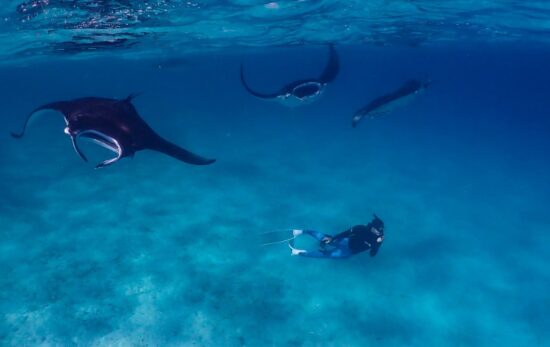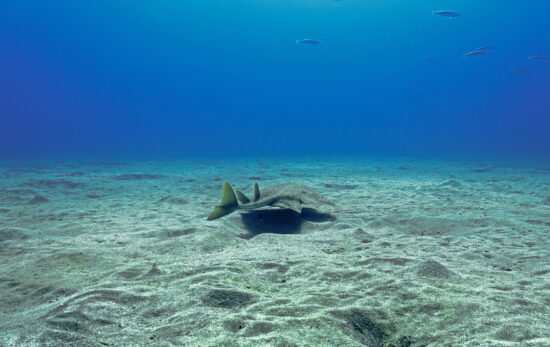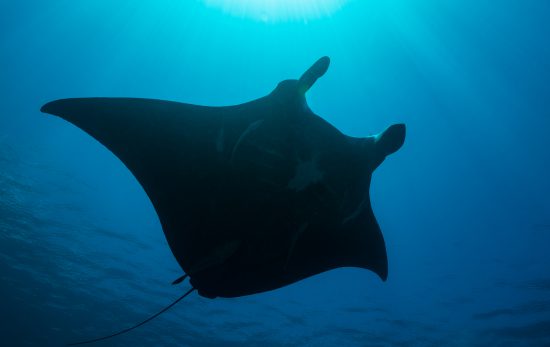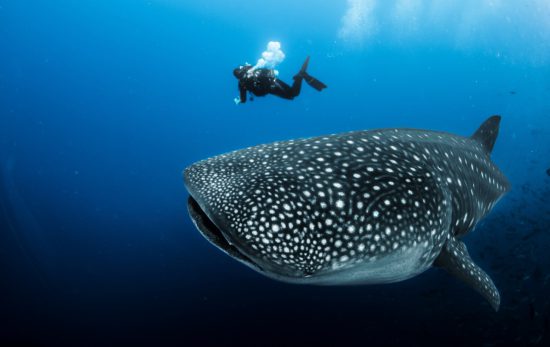It seems a bit redundant to say, “Here are # interesting facts about hammerhead sharks.” Seriously, what isn’t interesting about hammerhead sharks?
Whale sharks and great white sharks may get more attention, but hammerhead sharks are arguably more mysterious (and easier to find). Think of the first time you saw a photo of a hammerhead shark. You probably thought something along the lines of, “What the _____?”
Friends, hammerhead sharks are even more fascinating than you may realize. For example, did you know: one species of hammerhead is omnivorous? It eats seagrass in addition to familiar hammerhead shark fare such as: squid, crabs and shrimp.
Read on to discover more fun hammerhead shark facts.

FAQs About Hammerheads
Let’s start out with the answers to some of the most frequently asked questions about hammerheads.
What do hammerhead sharks eat?
Hammerheads primarily eat crustaceans, octopuses, squid and smaller fish. As mentioned above, one species is omnivorous. Great hammerheads also eat stingrays and other sharks (including other hammerheads).
What’s the smallest hammerhead shark?
Hammerheads, also known as sphyrnids, include any shark with a flat hammer or shovel-shaped head. These sharks grow to an average maximum size of 90 cm/35 in. The smallest of the nine species of hammerheads is the small scalloped bonnethead.
What’s the biggest hammerhead shark?
The largest species of hammerhead shark is the great hammerhead, which can grow to lengths of 6.1m (20ft). Want to get in the water with a great hammerhead shark? Head to Bimini in the Bahamas.
Where do hammerhead sharks live?
The hammerhead shark’s habitat includes temperate and tropical waters throughout the world. Hammerheads can often be seen cruising along continental shelves and coastlines but can also be found near the surface of deep water as well. Some hammerheads are particular about their preferred temperature and will migrate to warmer or cooler water as needed.
Can hammerheads see in front of them?
The short answer is: yes, hammerheads can see objects directly in front of them, but scientists weren’t completely sure this was true until 2009.
Different species of hammerheads have varying degrees of vision, but generally speaking, their visual field ranges between 308-340 degrees (humans have a visual field of about 190 degrees). This video from Real Science does a great job explaining a hammerhead’s field of vision.
Are hammerhead sharks dangerous?
The majority of hammerhead shark species are not considered dangerous to humans and are generally not aggressive. The risk of a hammerhead shark bite is very low, and these sharks generally only attack people if they are threatened or surprised. There have only been 17 recorded attacks around the world with no fatalities reported.
Are hammerhead sharks endangered?
Two hammerhead shark species are critically endangered: the scalloped hammerhead and the great hammerhead. The smooth hammerhead is considered vulnerable. Bycatch and the global shark fin trade are the greatest threats.
More Hammerhead Shark Facts
But, wait, there’s so much more to hammerhead sharks than people even know to ask about. These are some of our favorite, oddball hammerhead shark facts.
They Often Swim Sideways – Scientists suspect sideways swimming may be more efficient for this uniquely-shaped shark.
Hammerheads Can Get a Tan – After increased exposure to the sun, juvenile scalloped hammerheads can turn from light beige to brown.
Their Skull Is Hammer-Shaped – Inside a hammerhead shark’s head is one of the spookiest-looking skulls on Earth.
Hammerheads Use Their Heads to Pin Down Prey – That’s right! The distinctive shape does more than just give them superior vision. It can pin down prey, such as rays on the seafloor.
Hammerhead Sharks Are Younger Than Their Relatives – One University of Colorado study showed that hammerhead sharks developed only 20 million years ago. But sharks have been around for 420 million years, making these odd creatures newcomers on the world stage.
Ready to Dive In?
If you aren’t already a diver, get certified so you can see hammerhead sharks in the wild. Become a PADI® Open Water Diver and/or PADI Freediver. You can even start online right now. Then, connect with a PADI Dive Center or Resort to complete your in-water training.

Psst…Want to save big on your scuba diving courses or contribute to the amazing work PADI AWARE is doing to protect shark and ray species around the world? Join PADI Club! Benefits to members include 20% off select eLearning courses, a donation of 5% of your membership fee to ocean conservation, an exclusive speaker series (including several shark experts), PADI Gear discounts and more.





